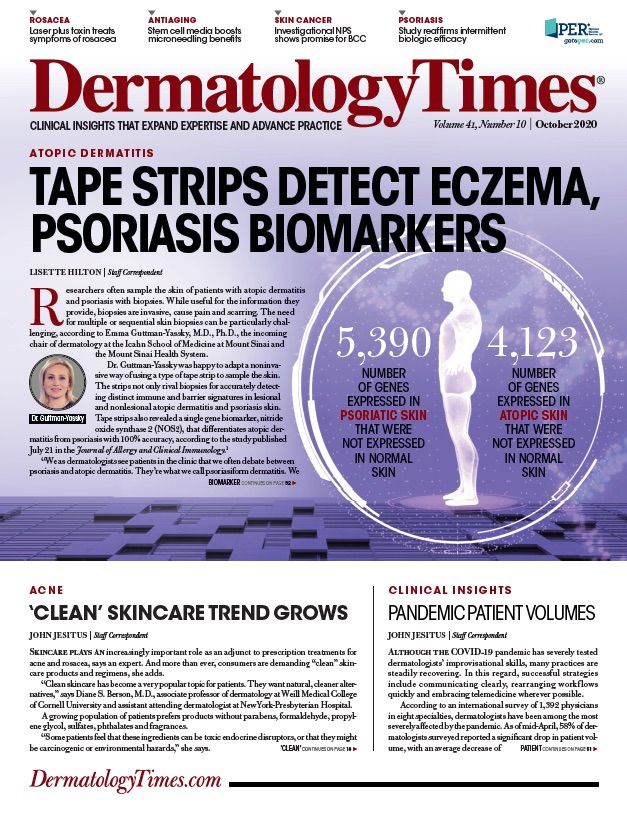- Case-Based Roundtable
- General Dermatology
- Eczema
- Chronic Hand Eczema
- Alopecia
- Aesthetics
- Vitiligo
- COVID-19
- Actinic Keratosis
- Precision Medicine and Biologics
- Rare Disease
- Wound Care
- Rosacea
- Psoriasis
- Psoriatic Arthritis
- Atopic Dermatitis
- Melasma
- NP and PA
- Skin Cancer
- Hidradenitis Suppurativa
- Drug Watch
- Pigmentary Disorders
- Acne
- Pediatric Dermatology
- Practice Management
- Prurigo Nodularis
- Buy-and-Bill
Publication
Article
Dermatology Times
Phenotype-based approach advances management
Author(s):
The 21-member global ROSacea Consensus panel developed updated recommendations for rosacea, diagnosis, classification and management to support and promote transition to a phenotype approach in rosacea.
In 2017, the global ROSacea Consensus (ROSCO) panel recommended transitioning from a subtype to a phenotype approach for rosacea diagnosis, classification and management.1 Updated recommendations on diagnosis, classification and management aim to promote uptake of this phenotype approach and account for advances in research. To that end, the document includes prototype clinical tools that should help practitioners use the phenotype approach.2
Richard Gallo, M.D., Ph.D., Irma Gigli Distinguished Professor and Chairman, department of dermatology, University of California San Diego School of Medicine, San Diego, is one of seven physicians from the United States who served on the international panel. He was also a member of the National Rosacea Society Expert Committee that recently released an updated report on management options for rosacea.3
“The two sets of guidelines closely align and show consensus among experts in the field," Dr. Gallo tells Dermatology Times. “The revised phenotype-based system for rosacea classification is an improvement that was created to better serve the needs of the individual rosacea patient. The new management guidelines acknowledge that rosacea frequently presents with multiple phenotypes. Recognizing the coexistence of several phenotypes enables better therapy.”
The consensus recommendations were developed using a modified Delphi process. Recommendations were accepted if at least three-fourths of the ROSCO panel members agreed or strongly agreed with the statements. The recommendations are divided into five sections and cover the following topics:
- Burden of disease and treatment goals
- Diagnosis, classification and assessment
- Treatment
- Monitoring
- Ocular rosacea
The recommendations on burden of disease and treatment goals direct clinicians to assess severity and identify its burden as part of a shared decision-making approach to treatment selection.

The Dermatology Life Quality Index (DLQI) and/or a series of alternative questions are suggested to assess psychosocial and functional impact of rosacea as well as the severity of disease signs and symptoms. The section also highlights that achieving “clear” or “almost clear” skin should be the primary treatment objective.
As an aid to diagnosis, classification and assessment, the article includes tables that provide descriptions of cutaneous rosacea features and considerations for assessing the severity of minor cutaneous rosacea features. A treatment algorithm appears in an appendix to the paper.
The recommendations on rosacea monitoring emphasize the need for ongoing follow-up because rosacea is a chronic disease. In addition, they identify tolerability, cost and primary efficacy as key factors to discuss during consultations to gain understanding of patient satisfaction with treatment.
Treatment adherence is also addressed in the section on monitoring, and the recommendations include a list of issues to discuss with patients as a means to promote adherence. The topics include expectations on treatment duration, time to onset of efficacy, non-medical interventions, need for maintenance therapy, chances of achieving clear skin and potential side effects.
In the section on ocular rosacea, the ROSCO panel identified under-diagnosis of the condition by dermatologists as a problem, and the group also cited optimal diagnosis of the condition, a description of its features, and evidence-based guidelines for ocular rosacea as unmet needs.
Nevertheless, the ROSCO panel reached a consensus on descriptions of ocular rosacea features, which are summarized in a table, as well as on indications for patient referral. The latter features include blepharokeratoconjunctivitis, sclerokeratitis, anterior uveitis and blepharoconjunctivitis. Based on input from the two ophthalmologists on the ROSCO panel, another table provides considerations for assessing the severity of ocular rosacea features. Dermatologists can also refer to a set of images available in an appendix to the article to aid in the identification of features of ocular rosacea and its diagnosis.
Promoting the phenotype approach
Although there is evidence that dermatologists are implementing the phenotype approach in rosacea in practice, some members of the ROSCO panel identified certain obstacles.
“Our next challenges are to work out how to best apply the phenotype approach and make it user friendly,” Dr. Gallo says.
To facilitate uptake, the group developed a clinical checklist and incorporated it into a prototype of its Rosacea Tracker tool. Refinement and validation of the instrument are future targets.
Broader implications
Dr. Gallo suggests that the recognition that rosacea patients may present with more than one phenotype is not just an advance for optimizing patient care at present, but it is also a step forward for designing research studies that may lead to more effective therapy.
“I expect the improvements in the classification system will accelerate development of improved therapeutic approaches for rosacea. In particular, we hope to better treat the phenotype of redness since this has been most resistant to current therapy,” he says.
References:
- Tan J, Almeida LMC, Bewley A et al. Br J Dermatol. 2017; 176:431–438.
- Schaller M, et al. Br J Dermatol. 2020;182(5):1269-1276.
- Thiboutot D, et al. J Am Acad Dermatol. 2020;82(6):1501-1510.
Disclosure:
Dr. Gallo has no relevant conflicts of interest to disclose relevant to this article.







